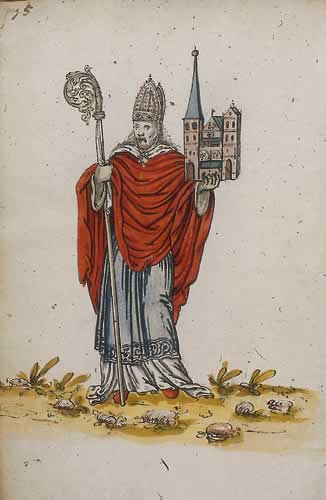By Kim Rendfeld
In 782, Saint Willehad was at a low point. Continental Saxons – the very people whose souls he was trying to save – had burned the churches he’d founded and slaughtered his followers.
I can imagine his heartbreak for his fellows and maybe for a dream that went back to his childhood in Northumbria. Perhaps, he grew up hearing stories of Saint Willibrord spreading Christianity in Frisia and Saint Boniface’s martyrdom. Perhaps, their spiritual heroism inspired him to become a missionary.
 |
| By Georg Sturm, circa 1885 (from Encyclopedie Drenthe Online, artikel Willehad, public domain, via Wikimedia Commons) |
But he was not always welcome. His preaching against the pagan religion raised the ire of the locals. He was saved when a chieftain decided to cast lots rather than execute him outright. He again faced danger when one of his followers destroyed idols, following Willibrord’s and Boniface’s examples. This time, he and his companions found refuge in the court of Frankish King Charles (today called Charlemagne).
It was an opportune time. In the 770s, the long-standing enmity between the Franks and the Saxons took a religious turn. Not only was Charles gaining territory; he supported missionaries in the conquered lands and made deals with Saxon aristocrats who accepted baptism. In 780, Charles held an assembly at Eresburg, a former Saxon stronghold. He sent Willehad to preach in Wigmodia, between the Weser and Elbe rivers, near Bremen. Charles went on to fight the Saxons that year.
Perhaps believing the situation was stable, Willehad ordained priests, probably as a chorbishop, and founded churches.
782 had a promising start. In the summer, Charles held an assembly at the source of the Lippe River, and every Saxon lord, except the charismatic Widukind, attended. This first capitulary to the Saxons was issued. Among other things, the document made capital offenses of refusing baptism, eating meat during Lent (unless excused for infirmity), burning a dead body, and infidelity to the king. After receiving other important guests, Charles returned to Francia.
But the Saxons weren’t as beaten into submission, I mean pacified, as Charles had thought. Widukind rallied discontented Saxons, who pillaged the countryside and burned churches. Willehad fled about 80 miles to Emden, at the mouth of the Ems River near the North Sea, and escaped by boat. He eventually made his way to Rome.
At some point, Willehad must have learned that the Saxons also inflicted devastating losses on the Franks in the Süntel Mountains. Politically, Charles could not let such an attack go unanswered. The offending Saxons were caught but let Widukind escape. So Charles, if we are to believe the annals, ordered the beheading of 4,500 men.
This brutal justice satisfied Charles’s counts, but how did the deaths affect Willehad? Did he, like the Frankish counts, believe himself avenged? Did he see the executions as a grim necessity to resume the Christian mission to Saxony? Or did he regret the lost souls and feel like a failure, wondering how he would answer to God?
 |
Woodcut from the late Middle Ages (public domain, via Wikimedia Commons) |
Charles continued the battles, and in 785, Widukind agreed to be baptized as part of a peace deal. The same year, Willehad returned to Bremen. He was consecrated as a bishop two years later. On November 1, 789, he celebrated the dedication of his church in Bremen, the seat of his diocese, to Jesus and Saint Peter.
He didn’t get to bask in his triumph. Exactly one week after the ceremony, he died of a fever while traveling in Blexen, a village north of Bremen. His last thoughts lingered on heaven. Perhaps, he was at peace with his fate. He could tell God he did everything he could to lead Saxons to the True Faith.
Sources
“The Life of Saint Willehad,” anonymous, translated by Peter J. Potter and Thomas F.X. Noble, from Soldiers of Christ: Saints and Saints' Lives from Late Antiquity and the Early Middle Ages, pgs. 279-291, edited by Thomas F.X. Noble, Thomas Head
"St. Willehad" by Francis Mershman, The Catholic Encyclopedia
Unam Sanctam Catholicam
The Lives of the Saints, Rev. Alban Butler
“Anglo-Saxon Period,” Volume 1 of Biographia Britannica Literaria: Or, Biography of Literary Characters of Great Britain and Ireland, Arranged in Chronological Order, Thomas Wright
Ansgar, Rimbert and the Forged Foundations of Hamburg-Bremen Church, Faith and Culture in the Medieval West, Eric Knibbs
Kim Rendfeld is the author of two books set in Carolingian Francia, The Cross and the Dragon and The Ashes of Heaven’s Pillar, and is working on Queen of the Darkest Hour. For more about Kim and her fiction, visit kimrendfeld.com or her blog, Outtakes. You can also connect with her on Facebook and Twitter.


Thanks for this fascinating article!
ReplyDeleteMany years ago when I was a baby History major I thought I would like to go into Mediaeval Studies; however, the lure of the Classics was greater. There is no type of ancient literature that I dislike more than hagiographies than the earlier apologetics, which are almost entirely lies. It does make the job of the historian much harder. Needless to say Charlemagne is not on my list of admired people.
ReplyDelete